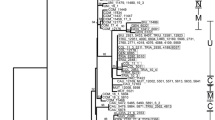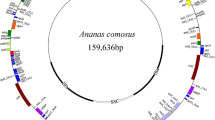Abstract.
Although universal or consensus chloroplast primers are available, they are limited by their number and genomic distribution. Therefore, a set of consensus chloroplast primer pairs for simple sequence repeats (ccSSRs) analysis was constructed from tobacco (Nicotiana tabacum L.) chloroplast sequences. These were then tested for their general utility in the genetic analysis of a diverse array of plant taxa. In order to increase the number of ccSSRs beyond that previously reported, the target sequences for SSR motifs was set at A or T (n ≥ 7) mononucleotide repeats. Each SSR sequence motif, along with ±200-bp flanking sequences from the first of each mononucleotide base repeat, was screened for homologies with chloroplast DNA sequences of other plant species in GenBank databases using BLAST search procedures. Twenty three putative marker loci that possessed conserved flanking sequence spans were selected for consensus primer pair construction using commercially available computer algorithms. All primer pairs produced amplicons after PCR employing genomic DNA from members of the Cucurbitaceae (six species) and Solanaceae (four species). Sixteen, 22 and 19 of the initial 23 primer pairs were successively amplified by PCR using template DNA from species of the Apiaceae (two species), Brassicaceae (one species) and Fabaceae (two species), respectively. Twenty of 23 primer pairs were also functional in three monocot species of the Liliaceae [onion (Allium cepa L.) and garlic (Allium sativum L.)], and the Poaceae [oat (Avena sativa L.)]. Sequence analysis of selected ccSSR fragments suggests that ccSSR length and sequence variation could be useful as a tool for investigating the genetic relationships within a genus or closely related taxa (i.e., tribal level). In order to provide for a marker system having significant coverage of the cucumber chloroplast genome, ccSSR primers were strategically "recombined" and named recombined consensus chloroplast primers (RCCP) for PCR analysis. Successful amplification after extended-length PCR of 16 RCCP primer pairs from cucumber (Cucumis sativus L.) DNA suggested that the amplicons detected are representative of the cucumber chloroplast genome. These RCCP pairs, therefore, could be useful as an initial molecular tool for investigation of traits related to a chloroplast gene(s) in cucumber, and other closely related species.


Similar content being viewed by others
References
Altschul SF, Gish W, Miller W, Myers EW, Lipman DJ (1990) Basic local alignment search tool. J Mol Biol 215:403–410
Bryan GJ, McNicoll J, Ramsay G, Meyer RC, De JWS (1999) Polymorphic simple sequence repeat markers in chloroplast genomes of Solanaceous plants. Theor Appl Genet 99:859–867
Chung S, Staub JE, Fazio G (2003) Inheritance of chilling injury: a maternally inherited trait in cucumber. J Am Soc Hort Sci (in press)
Demesure B, Sodzi N, Petit RJ (1995) A set of universal primers for amplification of polymorphic non-coding regions of mitochondrial and chloroplast DNA in plants. Mol Ecol 4:129–131
Demesure B, Comps B, Petit RJ (1996) Chloroplast DNA phylogeography of the common beech (Fagus sylvatica L.) in Europe. Evolution 50:2515–2520
Dumolin LS, Pemonge MH, Petit RJ (1997) An enlarged set of consensus primers for the study of organelle DNA in plants. Mol Ecol 6:393–397
Dunnill PM, Fowden L (1965) The amino acids of seeds of the Cucurbitaceae. Phytochemistry 4:933–944
Hiratsuka J, Shimada H, Whittier R, Ishibashi T, Sakamoto M, Mori M, Kondo C, Honji Y, Sun CR, Meng BY, Li YQ, Kanno A, Nishizawa Y, Hirai A, Shinozaki K, Sugiura M (1989) The complete sequence of the rice (Oryza sativa) chloroplast genome: intermolecular recombination between distinct tRNA genes accounts for a major plastid DNA inversion during the evolution of the cereals. Mol Gen Genet 217:185–194
Hupfer H, Swiatek M, Hornung S, Herrmann RG, Maier RM, Chiu WL, Sears B (2000) Complete nucleotide sequence of the Oenothera elata plastid chromosome, representing plastome I of the five distinguishable Euoenothera plastomes. Mol Gen Genet 263:581–585
Grivet D, Heinze B, Vendramin GG, Petit RJ (2001) Genome walking with consensus primers: application to the large single-copy region of chloroplast DNA. Mol Ecol Notes 1:345–349
Ishii T, McCouch SR (2000) Microsatellites and microsynteny in the chloroplast genomes of Oryza and eight other Gramineae species. Theor Appl Genet 100:1257–1266
Jeffrey C (1962) Notes on Cucurbitaceae, including a proposed new classification of the family. Kew Bull 15:337–371
Jeffrey C (1964) A note on pollen morphology in the Cucurbitaceae. Kew Bull 17:473–476
Jeffrey C (1980) A review of the Cucurbitaceae. Bot J Linn Soc 81:233–247
Jeffrey C (1990) An outline classification of the Cucurbitaceae. In: Biology and utilization of the Cucurbitaceae. Cornell University Press, Ithaca, NY, pp 449–463
Jobst J, King K, Hemleben V (1998) Molecular evolution of the internal transcribed spacers (ITS1 and ITS2) and phylogenetic relationships among species of the family Cucurbitaceae. Mol Phylog Evol 9:204–219
King RA, Ferris C (1998) Chloroplast DNA phylogeography of Alnus glutinosa L. Gaertn. Mol Ecol 7:1151–1161
McCauley DE (1995) The use of chloroplast DNA polymorphism in studies of gene flow in plants. Trends Ecol Evol 10:198–202
Mohanty A, Martin JP, Aguinagalde I (2000) Chloroplast DNA diversity within and among populations of the allotetraploid Prunus spinosa L. Theor Appl Genet 100:1304–1310
Ohyama K, Fukuzawa H, Kohchi T, Shirai H, Sano T, Umesono K, Shiki Y, Takeuchi M, Chang Z, Aota S, Inokuchi H, Ozeki H (1986) Complete nucleotide sequence of liverwort Marchantia polymorpha chloroplast DNA. Plant Mol Biol Rep 4:148–175
Orti G, Pearse DE, Avise JC (1997) Phylogenetic assessment of length variation at a microsatellite locus. Proc Natl Acad Sci USA 94:10,745–10,749
Powell W, Morgante M, McDevitt R, Vendramin G, Rafalski J (1995) Polymorphic simple-sequence repeat regions in chloroplast genomes: applications to the population genetics of pines. Proc Natl Acad Sci USA 92:7759–7763
Powell W, Morgante M, Doyle JJ, McNicol JW, Tingey SV, Rafalski AJ (1996) Genepool variation in the genus Glycine subgenus Soja revealed by polymorphic nuclear and chloroplast microsatellites. Genetics 144:792–803
Provan J, Corbett G, Waugh R, McNicol JW, Morgante M, Powell W (1996) DNA fingerprints of rice (Oryza sativa) obtained from hypervariable chloroplast simple-sequence repeats. Proc Roy Soc Lond B 263:1275–1281
Provan J, Russell JR, Booth A, Powell W (1999) Polymorphic chloroplast simple-sequence repeat primers for systematic and population studies in the genus Hordeum. Mol Ecol 8:505–511
Sanjur OI, Piperno DR, Andres TC, Wessel-Beaver L (2002) Phylogenetic relationships among domesticated and wild species of Cucurbita (Cucurbitaceae) inferred from a mitochondrial gene: implications for crop plant evolution and areas of origin. Proc Natl Acad Sci USA 99:535–540
Sato S, Nakmura Y, Kaneko T, Asamizu E, Tabata S (1999) Complete structure of the chloroplast genome of Arabidopsis thaliana. DNA Res 6:283–290
Shinozaki K, Ohme M, Tanaka M, Wakasugi T, Hayashida N, Matsubayashi T, Zaita N, Chungwongse J, Obokata J, Yamaguchi-Shinozaki K, Ohto C, Torazawa K, Meng BY, Sugita M, Deno H, Kamogashira T, Yamada K, Kusuda J, Takaiwa F, Kato A, Tohdoh N, Shimada H, Sugiura M (1986) The complete nucleotide sequence of the tobacco chloroplast genome: its gene organization and expression. EMBO J 5:2043–2049
Schmitz-Linneweber CR, Maier M, Alcaraz J, Cottet A, Herrmann RG, Mache R (2001) The plastid chromosome of spinach (Spinacia oleracea): complete nucleotide sequence and gene organization. Plant Mol Biol 45:307–315
Staub JE, Serquen FC, Gupta M (1996) Genetic markers, map construction, and their application in plant breeding. Hortscience 31:729–740
Staub JE, Serquen FC, McCreight JD (1997) Genetic diversity in cucumber (Cucumis sativus L.). III. An evaluation of Indian germplasm. Genetic Resour Crop Evol 44:315–326
Taberlet P, Gielly L, Pautou G, Bouvet J (1991) Universal primers for amplification of three non-coding regions of chloroplast DNA. Plant Mol Biol 17:1105–1110
Vendramin GG, Ziegenhagen B (1997) Characterization and inheritance of polymorphic plastid microsatellites in Abies. Genome 40:857–864
Vendramin GG, Lelli L, Rossi P, Morgante M (1996) A set of primers for the amplification of 20 chloroplast microsatellites in Pinaceae. Mol Ecol 5:595–598
Walters TW, Decker Walters DS, Posluszny U, Kevan PG (1991) Determination and interpretation of comigrating allozymes among genera of the Benincaseae (Cucurbitaceae). Syst Bot 16:30–40
Weising K, Gardner RC (1999) A set of conserved PCR primers for the analysis of simple sequence repeat polymorphisms in chloroplast genomes of dicotyledonous angiosperms. Genome 42:9–19
Wolfe KH, Li WH, Sharp PM (1987) Rates of nucleotide substitution vary greatly among plant mitochondrial, chloroplast, and nuclear DNA. Proc Natl Acad Sci USA 84:9054–9058
Yuan Q, Hill J, Hsiao J, Moffat K, Ouyang S, Cheng Z, Jiang J, Buell CR (2002) Genome sequencing of a 239-kb region of rice chromosome 10L reveals a high frequency of gene duplication and a large chloroplast DNA insertion. Mol Gen Genomics 267:713–720
Author information
Authors and Affiliations
Corresponding author
Additional information
Communicated by C. Möllers
Rights and permissions
About this article
Cite this article
Chung, SM., Staub, J.E. The development and evaluation of consensus chloroplast primer pairs that possess highly variable sequence regions in a diverse array of plant taxa. Theor Appl Genet 107, 757–767 (2003). https://doi.org/10.1007/s00122-003-1311-3
Received:
Accepted:
Published:
Issue Date:
DOI: https://doi.org/10.1007/s00122-003-1311-3




